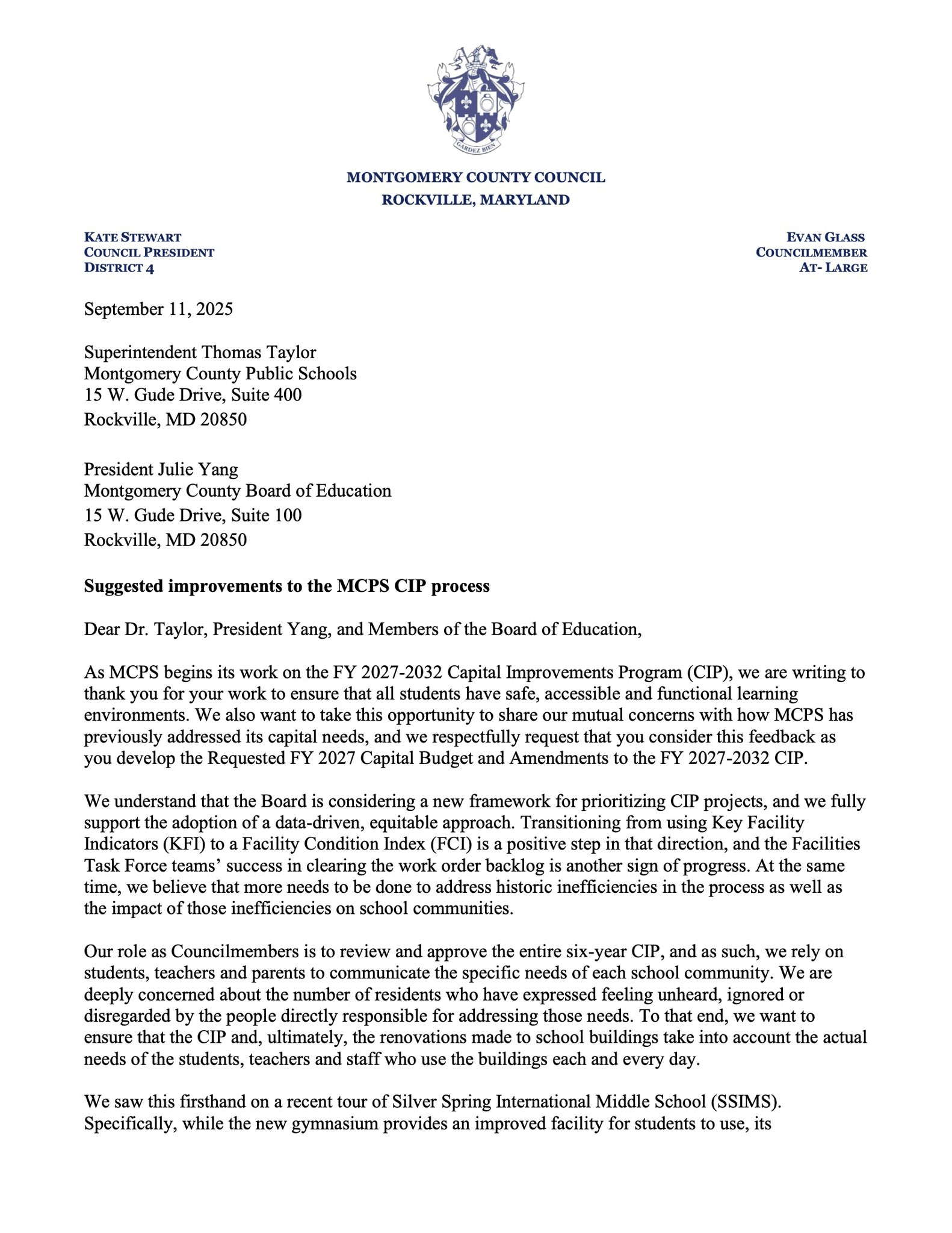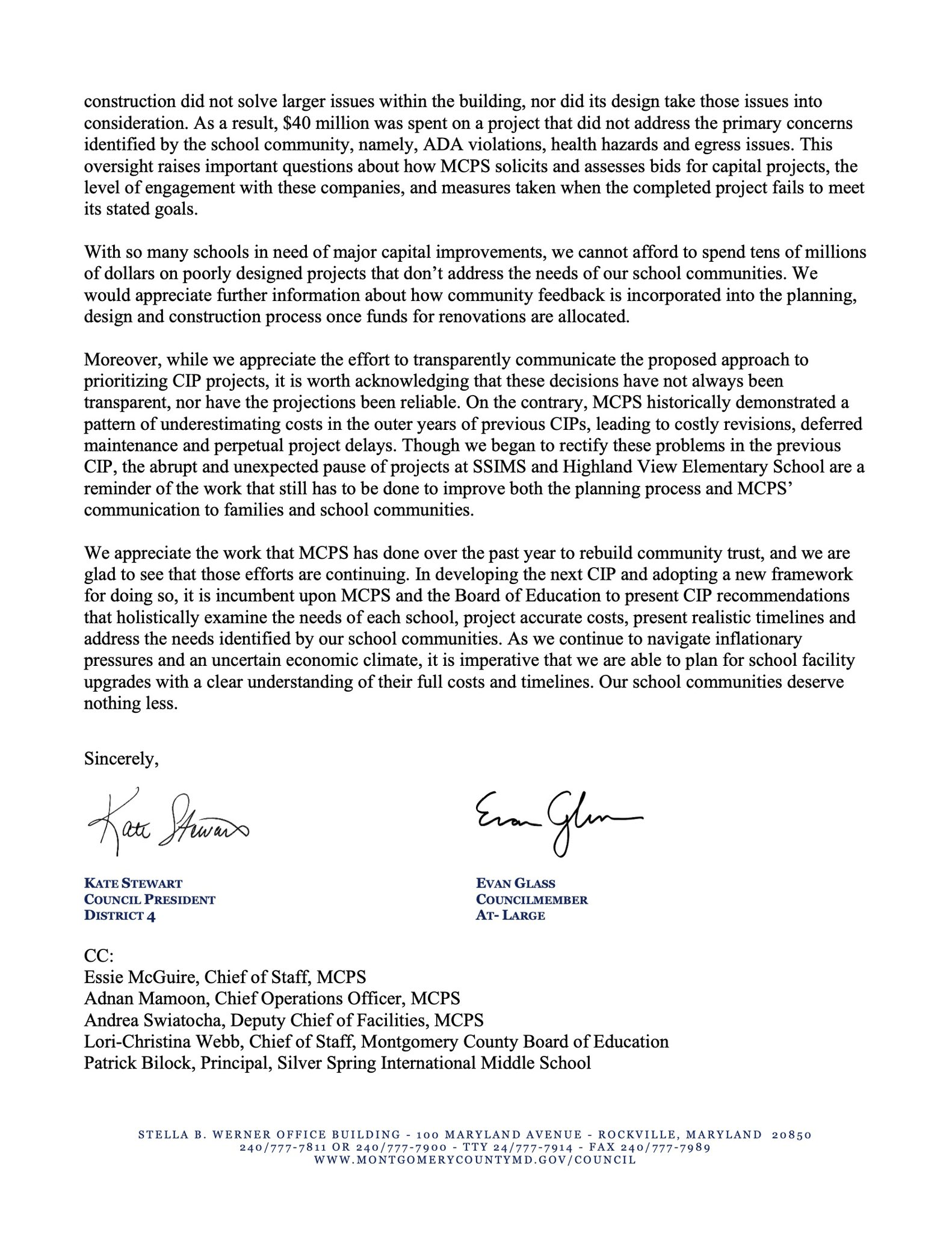By Adam Pagnucco.
School construction seems to make no one happy. If folks don’t get their project into MCPS’s school construction queue, they’re unhappy. If they do, the project takes forever to advance and might get delayed, which creates unhappiness. If the project gets to construction, it takes too long and creates noise and dirty conditions in the neighborhood, which creates… you guessed it… unhappiness. And when the project gets finished, it could come in over budget, which… need I say more?
So it’s easy to criticize MCPS’s capital decisions. And they matter since MCPS’s capital budget totals nearly $1.8 billion over the next six years, about 29% of the county’s entire capital budget. As capital revenues tighten, especially given an all-out collapse in impact tax receipts, it’s understandable that county leaders would want to scrutinize one of the largest components of capital spending.
That brings us to Council Members Kate Stewart and Evan Glass. Three weeks ago, they wrote a thoughtful critique about MCPS’s capital decision-making to Board of Education President Julie Yang and Superintendent Thomas Taylor. Glass posted the letter on Facebook. It’s worth a read and is reprinted below.
*****
September 11, 2025
Superintendent Thomas Taylor
Montgomery County Public Schools
15 W. Gude Drive, Suite 400
Rockville, MD 20850
President Julie Yang
Montgomery County Board of Education
15 W. Gude Drive, Suite 100
Rockville, MD 20850
Suggested improvements to the MCPS CIP process
Dear Dr. Taylor, President Yang, and Members of the Board of Education,
As MCPS begins its work on the FY 2027-2032 Capital Improvements Program (CIP), we are writing to thank you for your work to ensure that all students have safe, accessible and functional learning environments. We also want to take this opportunity to share our mutual concerns with how MCPS has previously addressed its capital needs, and we respectfully request that you consider this feedback as you develop the Requested FY 2027 Capital Budget and Amendments to the FY 2027-2032 CIP.
We understand that the Board is considering a new framework for prioritizing CIP projects, and we fully support the adoption of a data-driven, equitable approach. Transitioning from using Key Facility Indicators (KFI) to a Facility Condition Index (FCI) is a positive step in that direction, and the Facilities Task Force teams’ success in clearing the work order backlog is another sign of progress. At the same time, we believe that more needs to be done to address historic inefficiencies in the process as well as the impact of those inefficiencies on school communities.
Our role as Councilmembers is to review and approve the entire six-year CIP, and as such, we rely on students, teachers and parents to communicate the specific needs of each school community. We are deeply concerned about the number of residents who have expressed feeling unheard, ignored or disregarded by the people directly responsible for addressing those needs. To that end, we want to ensure that the CIP and, ultimately, the renovations made to school buildings take into account the actual needs of the students, teachers and staff who use the buildings each and every day.
We saw this firsthand on a recent tour of Silver Spring International Middle School (SSIMS). Specifically, while the new gymnasium provides an improved facility for students to use, its construction did not solve larger issues within the building, nor did its design take those issues into consideration. As a result, $40 million was spent on a project that did not address the primary concerns identified by the school community, namely, ADA violations, health hazards and egress issues. This oversight raises important questions about how MCPS solicits and assesses bids for capital projects, the level of engagement with these companies, and measures taken when the completed project fails to meet its stated goals.
With so many schools in need of major capital improvements, we cannot afford to spend tens of millions of dollars on poorly designed projects that don’t address the needs of our school communities. We would appreciate further information about how community feedback is incorporated into the planning, design and construction process once funds for renovations are allocated.
Moreover, while we appreciate the effort to transparently communicate the proposed approach to prioritizing CIP projects, it is worth acknowledging that these decisions have not always been transparent, nor have the projections been reliable. On the contrary, MCPS historically demonstrated a pattern of underestimating costs in the outer years of previous CIPs, leading to costly revisions, deferred maintenance and perpetual project delays. Though we began to rectify these problems in the previous CIP, the abrupt and unexpected pause of projects at SSIMS and Highland View Elementary School are a reminder of the work that still has to be done to improve both the planning process and MCPS’ communication to families and school communities.
We appreciate the work that MCPS has done over the past year to rebuild community trust, and we are glad to see that those efforts are continuing. In developing the next CIP and adopting a new framework for doing so, it is incumbent upon MCPS and the Board of Education to present CIP recommendations that holistically examine the needs of each school, project accurate costs, present realistic timelines and address the needs identified by our school communities. As we continue to navigate inflationary pressures and an uncertain economic climate, it is imperative that we are able to plan for school facility upgrades with a clear understanding of their full costs and timelines. Our school communities deserve nothing less.
Sincerely,
Kate Stewart
Council President
District 4
Evan Glass
Councilmember At-Large


